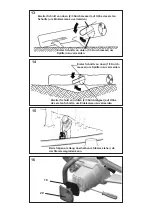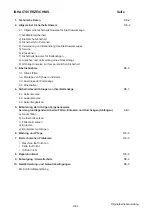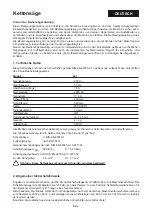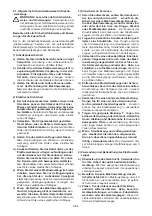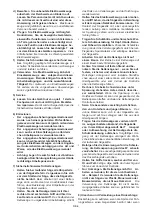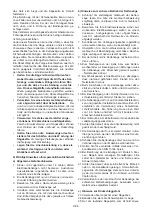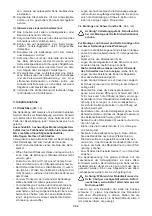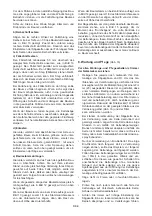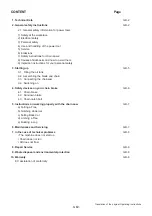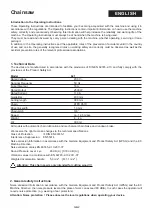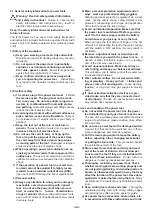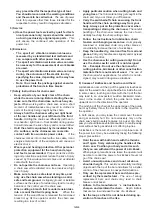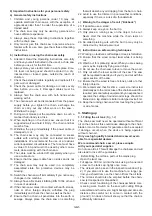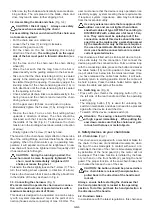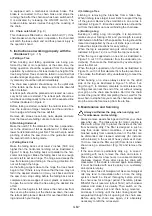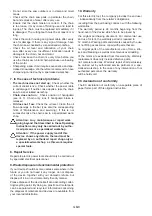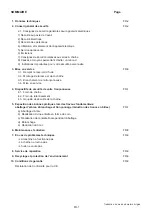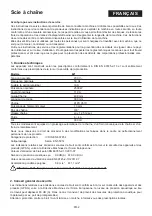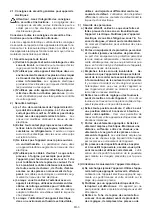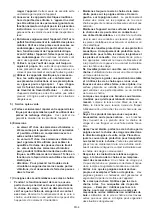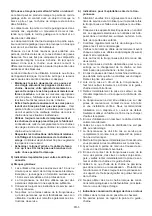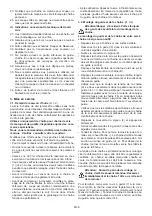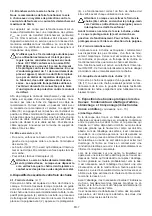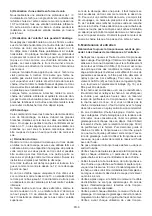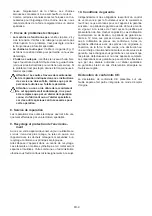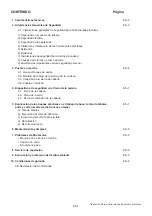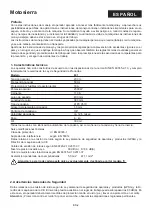
GB-4
way prescribed for the respective type of tool.
You should also consider the working conditions
and the work to be carried out.
The use of power
tools for purposes other than those intended for the
respective tool may result in dangerous situations.
5) Service
a) Have the power tool serviced by quali f ed tech-
nical personnel only; repairs should be carried
out using exclusively original spare parts.
This
will ensure the continued safe operation of the
power tool.
6) Emissions
- The specif ed vibration emission value was
measured by a standardized test methods and
can compare with other power tools are used.
- The specif ed vibration emission value can also
be necessary for the assessment of work breaks
are used.
- The specif ed vibration emission value can vary
during the actual use of the electric tool by
specifying the value, depending on the way how
to use the power tool.
- Note: You create the privilege against vascular
pulsations of the hands in time breaks
7) Safety instructions for chain saws:
• Keep all parts of your body clear of the chain
while the saw is running. Before starting the saw,
make sure that the chain does not touch any ob-
jects.
When working with a chain saw, even a short
moment of inattentiveness may result in clothes or
parts of the body being caught by the chain.
• Always hold the chain saw with your right hand
at the rear handle and your left hand at the front
handle.
Holding the chain saw differently (left hand –
rear handle / right hand – front handle) during opera-
tion will increase the risk of injury and is not permitted.
• Hold the electric equipment by its insulated han-
dle surfaces, as the chainsaw can come into
contact with its own mains power cable.
If the
chainsaw comes into contact with a live cable, it can
energise metal parts of the equipment and cause an
electric shock.
• Wear eye and hearing protection. Other personal
protection equipment for the head, hands, legs
and feet is recommended.
Proper protective cloth-
ing and protection equipment reduce the risk of injury
caused by thrown-about wood chips and accidental
contact with the chain.
• Do not operate the chain saw on trees.
Operating
a chain saw while situated on a tree involves a high
risk of injury.
• Make sure to have a safe stand at any time, and
only use the chain saw when standing on solid,
safe and level ground.
A slippery ground or instable
surfaces as the steps of a ladder may lead to loosing
balance or the control over the chain saw.
• When cutting a branch that is under tension take
into account that it will spring back.
When the
tension of the wood fi bres is released the tensioned
branch may hit the operator and/or the chain saw
resulting in a loss of control.
• Apply particular caution when cutting brush and
young trees.
The thin material may get caught in the
chain and hit you or throw you off balance.
• Carry the switched-off chain saw using the front
handle with the chain pointing away from your
body. Always put on the protection cover when
transporting or storing the chain saw.
The careful
handling of the chain saw reduces the risk of acci-
dentally touching the sharp cutting chain.
• Follow the instructions for lubrication, chain
tension and changing accessories.
An improperly
tensioned or lubricated chain may either break or
considerably increase the risk of a kickback.
• Keep the handles dry, clean and free from oil and
grease.
Fatty, oily handles are slippery and may lead
to a loss of control.
• Use the chain saw for cutting wood only! Do not
use the chain saw for works it is not designed
for. – Example: Do not use the chain saw for
cutting plastics, brickwork or other construction
materials that are not made of wood.
The use of
the chain saw for applications, for which it is not de-
signed, may result in dangerous situations.
8) Causes of kickbacks and how to avoid them:
A kickback can occur if the tip of the guide bar touches an
object or the wood to be cut pinches the bar inside the cut.
In some cases, touching an object with the tip of the bar
may lead to an unexpected, sudden backward move-
ment, in the course of which the guide bar is ‘kicked’
upwards and in the direction of the operator.
The pinching of the chain at the upper edge of the guide
bar may fi ercely throw the bar back in the direction of
the operator.
In both cases, you may loose the control over the saw
and get seriously hurt. Do not exclusively rely on the
chain saw’s built-in safety features. As a user of a chain
saw you should take several precautions to continuously
work without having accidents or suffering injuries.
A kickback is the result of a wrong or improper use of
the power tool. It may be avoided by taking the following
proper precautions:
• Hold the saw with both hands with the thumbs
and f ngers f rmly embracing the handles of the
chain saw. Position your body and arms such
that you can withstand the power of a kickback.
When proper precautions are taken the operator will
be able to control the power of a kickback. Never let
go of the chain saw!
• Avoid unusual postures and do not cut above
shoulder height.
This avoids accidentally touching
objects with the tip of the bar and allows for a better
control of the chain saw in unexpected situations.
• Only use the replacement bars and chains pre-
scribed by the manufacturer .
The use of wrong
replacement bars and chains may lead to chain
breaks or kickbacks.
• Adhere to the manufacturer ’s instructions to
sharpen and maintain the chain.
Depth limiters
that are too low increase the risk of a kickback.
• Set the loop so that it is not detected during op-
eration of branches or the like.


